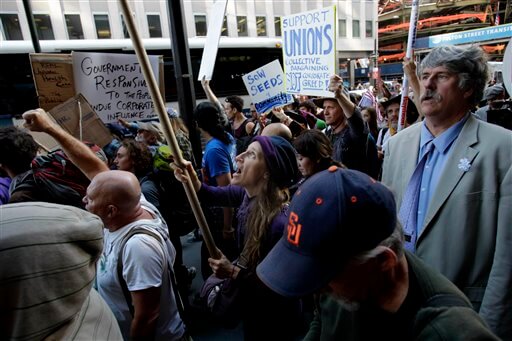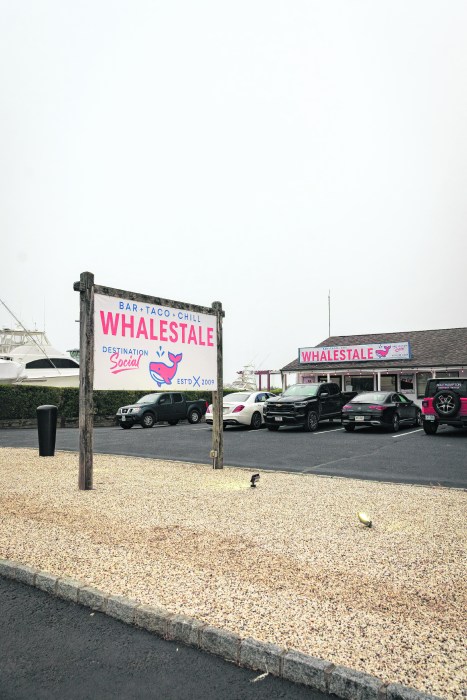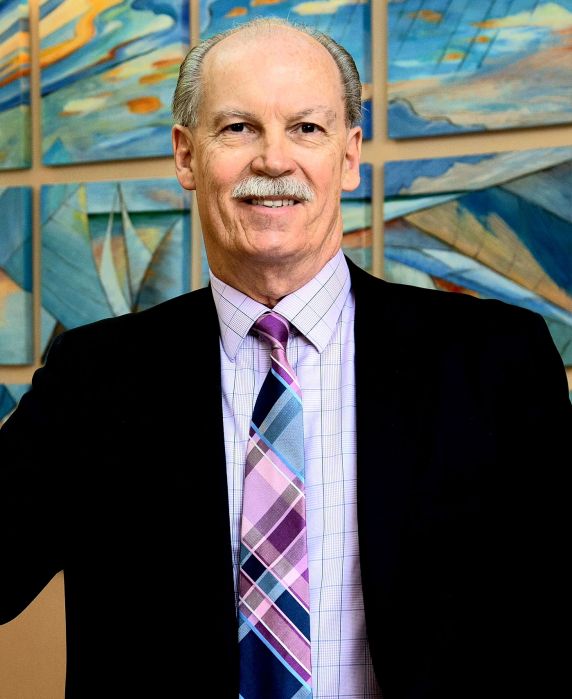
As other protesters chanted vigorously around her, Nancy Pi-Sunyer stood off to the side at the Occupy Wall Street rally, clutching her sign, looking a little like a new teacher on the first day of school.
In a way, she was: At 66, this retired teacher was joining a protest for the first time in her life.
“I was too young for the civil rights movement,” Pi-Sunyer said earlier this week as she joined thousands of protesters marching in lower Manhattan. “And during the Vietnam War, I was too serious a student. Now, I just want to stand up and have my voice be heard.”
As the protests have expanded and gained support from new sources, what began three weeks ago as a group of mostly young people camping out on the streets has morphed into something different: an umbrella movement for people of varying ages, life situations and grievances, some of them first-time protesters.
There are a few common denominators among the protesters: their position on the left of the political spectrum, and the view that the majority in America — the “99 percent,” in their words — isn’t getting a fair shake.
Beyond that, though, there’s a diversity of age, gender and race — in part due to the recent injection of labor union support, and fueled by social networks — that is striking to some who study social protests.
“Most people think this is a bunch of idealistic young kids,” said Heather Gautney, a sociology professor at Fordham University and an analyst of social protests. “But the wider movement is remarkably more diverse than it’s been portrayed. I’ve seen a lot of first-time protesters, nurses, librarians. At one protest, the younger element seemed actually to be in the minority.”
Pi-Sunyer, who lives in Montclair, N.J., was drawn into the fray on Wednesday the same way many were — via social networks. She saw a post from a friend on Facebook and realized it was time to join.
“I just decided to get off the couch and be in control,” she said, holding a hand-lettered sign that read: “Wise OWLS Seek Economic Justice 4 All.” (OWLS was a play on the initials for Occupy Wall Street — with an “l” for little people.) “I was oblivious before. I can’t be oblivious now.”
Nearby, a speaker in lower Manhattan’s Foley Square yelled into a microphone: “I’m tired of sticking my hand in my pocket, and only getting my leg!” The so-called “Granny Brigade” pulled out guitars and played a song. The crowd milled, bearing an endless variety of signs:
“Make Banks Pay!” ”Corporate Greed is Not Patriotic!” ”Give My Professor Health Insurance, Please!” ”Food is A Basic Human Right!” ”Bernanke Burnout!” An optimistic one: “This Is The First Time I’ve Felt Hopeful In a Long Time!” And a pessimistic one: “Even My Union is Corrupt!”
Cherie Walters wasn’t carrying a sign — she WAS a sign. Both the front and back of her shirt were covered in scrawled slogans.
“I came here from MICHIGAN because the top 20 percent are waging class warfare against the rest of the U.S.,” it read in part. Walters, 58, also a former teacher, had driven all the way from Michigan with her husband, Rich.
Her biggest gripe: credit card swipe fees, which she said were killing smaller businesses. She also was concerned about unemployment in her home state. “I’m very angry at how poverty is degrading our people,” she said. As she spoke, a much younger protester interrupted her to hand her a leaflet on health care reform.
The couple, who’d been following the protests all week, getting updates via Facebook and Twitter (and posting their own video on YouTube), complained that protesters had been described by others as unruly mobs or young troublemakers. Did she look like a young troublemaker, Walters asked? (At least there was a silver lining, she quipped: It was flattering to be described as young.)
Both Cherie and Rich Walters had protested during the Vietnam War, as students at Central Michigan University. Compared with those anti-war protests, she said, this one was way more diverse — “different ages, colors, even languages,” she said. Legal Aid lawyer Steve Wasserman, 63, who joined Wednesday’s march with his union and remembered his Vietnam protesting days, agreed. “The old left was very male-dominated,” he said.
Such diversity is what organizers were hoping for, said Patrick Bruner, spokesman for Occupy Wall Street. Since launching the protests in mid-September with a group of mostly young activists, “we’ve made a concerted effort to diversify our group,” he said, with an outreach committee and caucus groups for people of color, for example, or for women. “We’ve gradually seen our message resonate with different groups of people.”
Organizers also have been encouraging people to tell their stories in a virtual protest on tumblr, the social network, spotlighting people of different backgrounds, each tale of economic hardship ending with: “I am the 99 percent.”
Experts say the role of social networks in building and organizing these protests, like in the recent revolt in Egypt, can’t be overstated. “I’ve been studying and attending protests for a decade, and Facebook is the most effective organizing tool I have ever encountered,” said Michael Heaney, a professor at the University of Michigan.
What the movement doesn’t have right now, these experts note, are the same concrete goals of some past social movements — a lack that many demonstrators seem to be embracing, at least for the moment.
“We’re a broad range — everyone’s affected in a different way,” said John Crisano, 27, who’d answered a call for college students to attend Wednesday’s protest. “But we’re all here because we’re upset at the way the government is being run.”
Karen Livecchia, 49, agreed. “For now, it’s a lot like the Internet — leaderless, spaceless,” she said as she collected signatures at the march, spurred to action by an email from the liberal group MoveOn.org. “It’s hard to tell what it will lead to. But I’m not concerned that we don’t have specific demands — that will come.”
Livecchia, a Harvard grad with a master’s from New York University, was laid off 21 months ago from her publishing job, and for her, too, this was the first protest of her life. Her anger was palpable.
“I did everything I was supposed to do,” she said. “I have two fancy degrees. I’m from a union home, raised to believe in the system. But you know what? The system doesn’t work! It’s too polluted with corporate money.”
“If it’s like this for me,” she added, “how about the waiters, and the truck drivers?
What led Abdullah Pollard to the protests, just months after he became a U.S. citizen, was no less than the dashing of his American dream.
Pollard, 58, came to the United States from Trinidad in 1996, and became a citizen in June. “I didn’t feel empowered as an immigrant,” he said at Wednesday’s march, where he volunteered as a marshal. “Now I am a citizen, and I want to stand up for the downtrodden.”
A father of three adult kids, Pollard was laid off in April from his job in telecommunications. He’s looking for work again but said it’s hard at his age. He feels let down by a country where, he said, “both political parties march to the same drummer — the powerful corporations.”
“You leave your own country and you expect things to be better in America, a step or two up from what you left back home,” he said. “And then there’s this rude awakening.
“America is just not what it used to be.”
___
Online:
http://wearethe99percent.tumblr.com/page/2
Copyright 2011 The Associated Press.
































